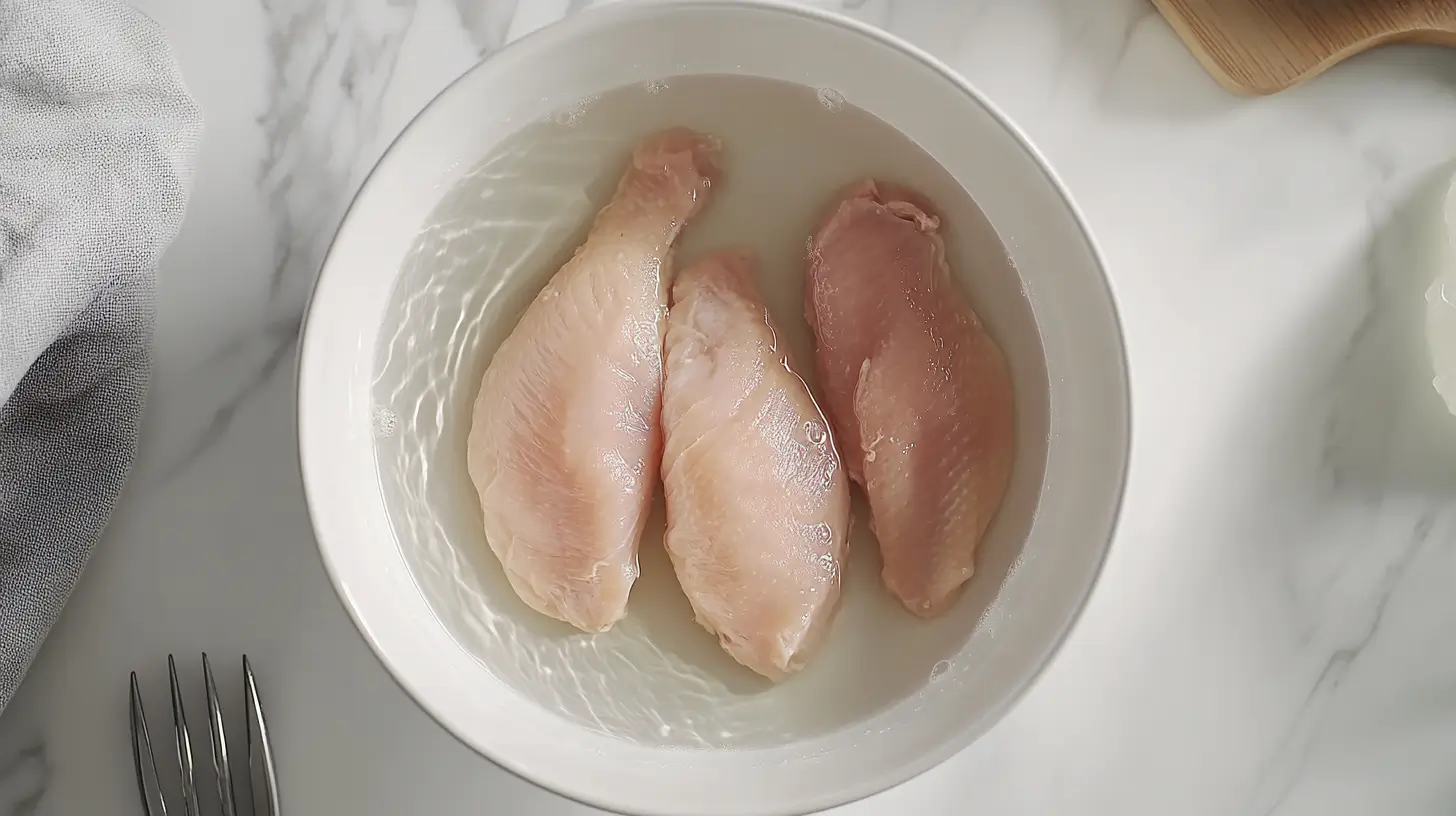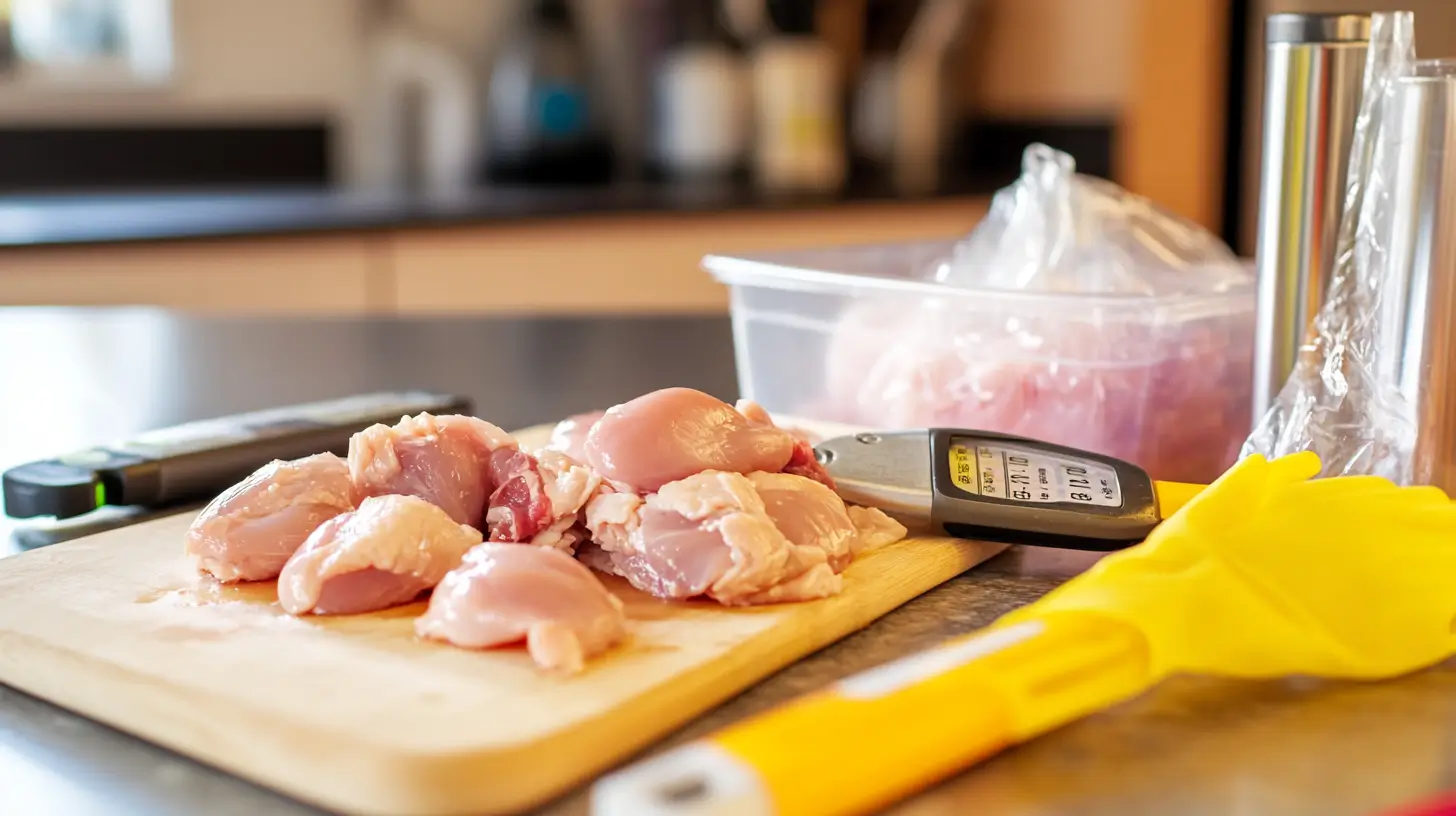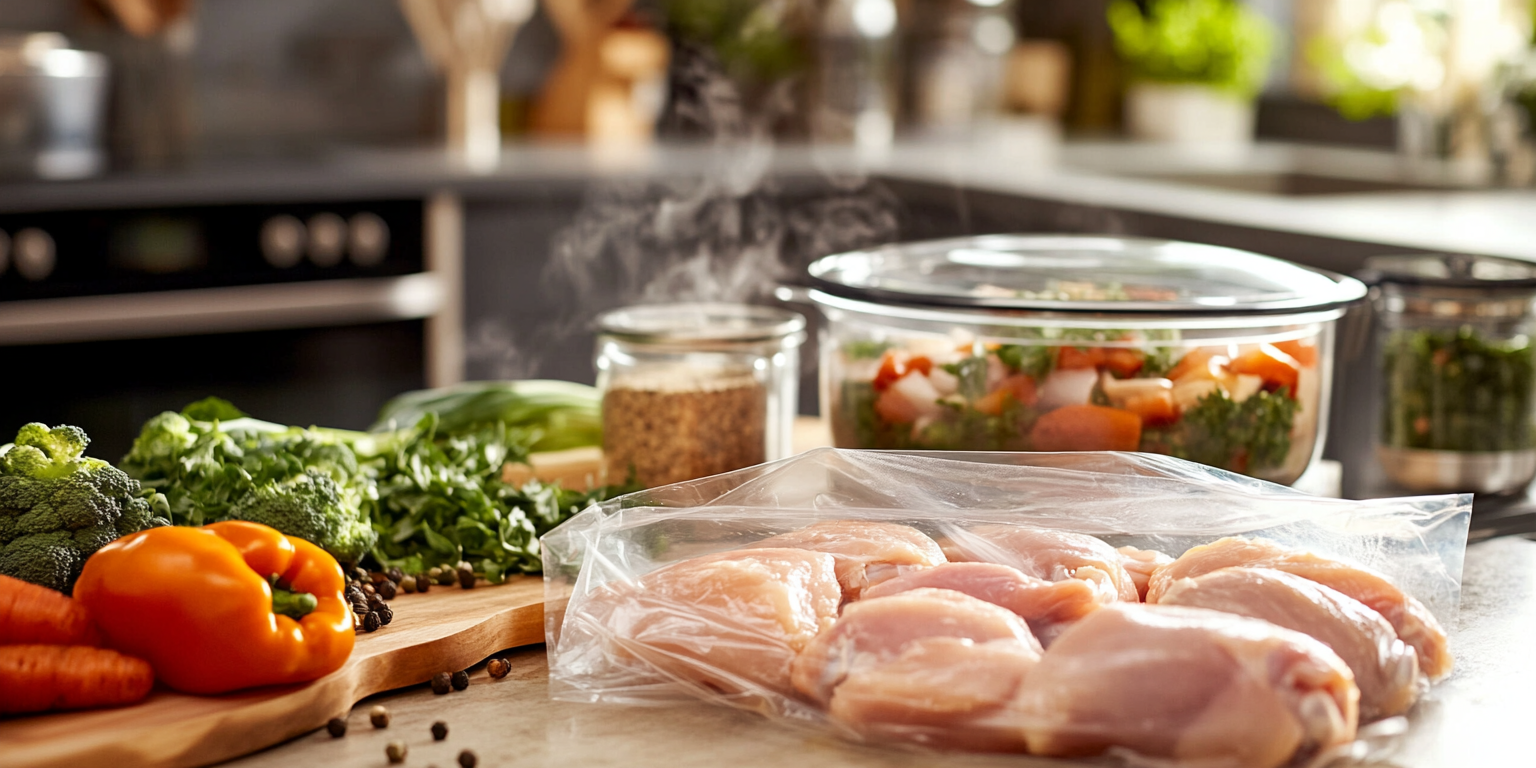How do you defrost chicken before a Crock-Pot? Cooking chicken in a Crock-Pot is a convenient way to prepare hearty, flavorful meals. However, defrosting chicken correctly before placing it in your slow cooker is essential. This ensures both food safety and optimal cooking results. In this article, we will delve into everything you need to know about how to defrost chicken before a Crock-Pot to achieve the best outcomes.
Defrosting chicken safely is a critical step in meal preparation. Whether you’re making a comforting stew or a simple chicken soup in your Crock-Pot, ensuring the chicken is fully thawed impacts both its texture and flavor. This practice not only minimizes risks but also enhances the quality of your dish.
What is a Crock-Pot and Why Does It Matter for Defrosting Chicken?
Understanding the Crock-Pot’s Functionality for Defrosting and Cooking
A Crock-Pot is a type of slow cooker designed to prepare meals over an extended period at low temperatures. Its primary function is to maintain consistent heat, allowing flavors to meld while tenderizing tougher cuts of meat. This unique cooking method makes the Crock-Pot a versatile kitchen tool for busy households.
Benefits of Slow Cooking
Slow cooking offers multiple advantages:
- Retains nutrients by cooking at lower temperatures.
- Enhances the natural flavors of ingredients.
- Reduces the need for added fats or oils.
- Saves time, as it allows hands-off cooking.
Given these benefits, preparing ingredients like chicken properly, including safe defrosting, ensures you maximize the potential of your Crock-Pot recipes.
Why Proper Defrosting is Crucial
Food Safety Risks of Improper Defrosting
Improper defrosting can lead to bacterial growth, especially in poultry. Salmonella and Campylobacter, common pathogens in raw chicken, thrive in the “danger zone” between 40°F and 140°F. This risk makes it critical to thaw chicken safely before using your Crock-Pot.
Impact on Cooking Quality
Defrosting chicken properly also influences the cooking process. Frozen or partially thawed chicken may cook unevenly in a Crock-Pot, resulting in dry or rubbery textures. Moreover, slow cookers may not heat frozen chicken quickly enough to reach safe internal temperatures, compromising both safety and quality.
Methods to Defrost Chicken Safely Before a Crock-Pot
Refrigerator Method
The refrigerator method is widely regarded as the safest way to defrost chicken before placing it in a Crock-Pot. This technique maintains the chicken at a safe temperature throughout the process, reducing the risk of bacterial growth.
Cold Water Method
The cold water method is a faster alternative, ideal when time is limited. It involves submerging the chicken in cold water and changing the water every 30 minutes to maintain its temperature.
Microwave Method
Using a microwave to defrost chicken is convenient but requires attention to detail. While this method speeds up the process, uneven thawing may occur, necessitating immediate cooking to prevent bacterial growth.
Should You Defrost at Room Temperature?
Defrosting chicken at room temperature is not recommended. The exterior of the chicken may enter the “danger zone” long before the interior fully thaws, increasing the risk of foodborne illness. Always opt for safer methods like refrigeration or cold water.
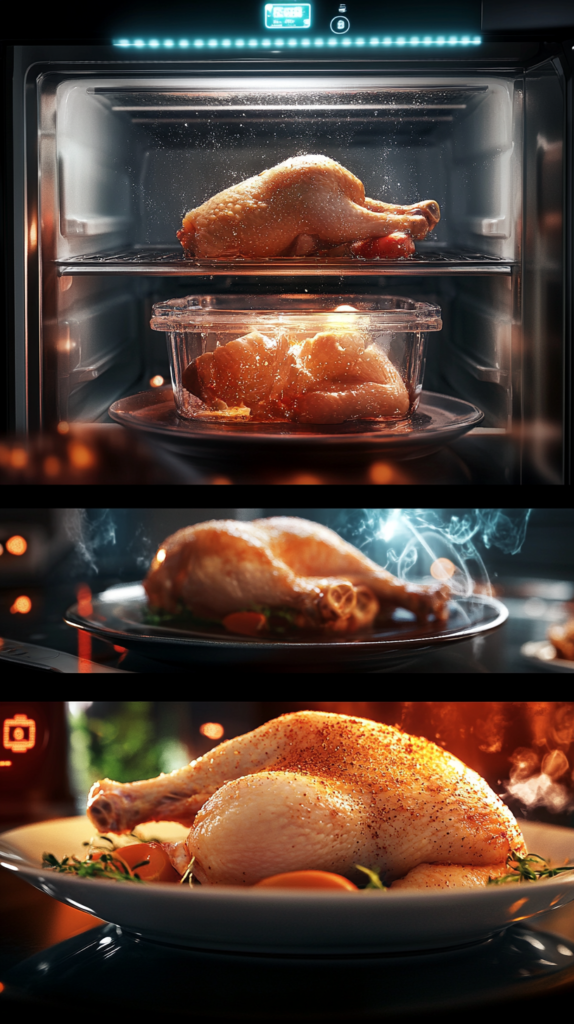
Step-by-Step Guide: Refrigerator Method for Defrosting Chicken Before a Crock-Pot
Preparation and Timing
- Place the chicken in a leak-proof container or sealed plastic bag to prevent juices from contaminating other foods.
- Arrange the chicken on the bottom shelf of your refrigerator to avoid cross-contamination.
- Ensure your refrigerator is set to 40°F or lower.
How Long Does It Take?
The time required for defrosting depends on the weight and size of the chicken:
- Boneless chicken breasts: 12–24 hours.
- Whole chicken: 24–48 hours.
- Chicken pieces with bones: 24–36 hours.
Always plan ahead to allow sufficient time for defrosting.
Step-by-Step Guide: Cold Water Method for Crock-Pot Chicken Defrosting
Supplies Needed
To defrost chicken using the cold water method, you’ll need:
- A large bowl or basin.
- Cold tap water.
- A sealed plastic bag to contain the chicken.
Ensuring Safety During the Process
- Submerge the chicken in cold water, ensuring it is fully covered.
- Replace the water every 30 minutes to keep it cold.
- Monitor the process closely and ensure the chicken thaws evenly.
This method is significantly faster than refrigeration, typically taking 2–3 hours for small cuts of chicken and up to 4–6 hours for larger pieces.
Step-by-Step Guide: Microwave Method
Choosing the Right Settings
The microwave method is ideal when you need to defrost chicken quickly before using your Crock-Pot. Follow these steps to ensure safe and effective thawing:
- Use the defrost setting on your microwave. Most microwaves have a preset for poultry or meat.
- Check the weight of the chicken, as the defrost time will depend on it.
- Place the chicken in a microwave-safe dish to catch any juices and prevent mess.
Precautions to Prevent Partial Cooking
Microwave defrosting often results in uneven thawing, where some parts of the chicken may begin to cook. To avoid this:
- Rotate the chicken periodically during defrosting.
- Check the chicken frequently and stop the microwave if parts are getting too warm.
- Cook the chicken immediately after defrosting to ensure safety.
How to Identify Properly Defrosted Chicken for a Crock-Pot
Signs of Fully Thawed Chicken
Knowing when your chicken is completely defrosted is essential for both safety and cooking quality. Look for these signs:
- The chicken feels pliable and soft throughout.
- No ice crystals remain inside or on the surface.
- Juices are present but not frozen.
What to Avoid
Avoid using partially frozen chicken in your Crock-Pot. Partially thawed chicken can:
- Cook unevenly, resulting in undercooked or overcooked areas.
- Fail to reach safe internal temperatures in time, increasing bacterial risks.
What to Do After Defrosting
Handling Chicken Safely
After defrosting chicken, take the following precautions:
- Wash your hands thoroughly before and after handling raw chicken.
- Use clean cutting boards, knives, and utensils to avoid cross-contamination.
- Cook the chicken immediately if it was defrosted using the microwave or cold water method.
Marinating Options Before Crock-Pot Cooking
Marinating your chicken after defrosting can enhance the flavor of your dish. Consider these tips:
- Use resealable bags or airtight containers to marinate chicken safely.
- Store the marinated chicken in the refrigerator until ready to cook.
- Avoid reusing marinade that has come into contact with raw chicken unless it has been boiled.
Common Mistakes to Avoid
Defrosting chicken safely before placing it in a Crock-Pot is critical for both food safety and cooking success. However, some common mistakes can compromise the quality of your meals or pose health risks. Here are two key errors to watch out for and why avoiding them is essential.
Forgetting to Plan Ahead
One of the most common mistakes when cooking chicken is underestimating how much time proper defrosting actually takes. Using the refrigerator method—the safest option—can require anywhere from 12 to 48 hours, depending on the size and cut of the chicken. In a rush, many turn to unsafe shortcuts like defrosting at room temperature or partially cooking the chicken to speed things up, both of which can pose food safety risks.
If you forget to plan ahead, it’s easy to feel tempted by faster but less reliable methods, often resulting in uneven thawing or increased risk of bacterial contamination. To avoid this, always consider the chicken’s size and weight when scheduling your meal prep. A little planning goes a long way in keeping your meals both stress-free and safe.
Using Hot Water for Defrosting
Although it might seem like a convenient shortcut, using hot water to defrost chicken is unsafe and should always be avoided. Hot water causes the outer layers of the chicken to reach the “danger zone” (40°F–140°F), where harmful bacteria like Salmonella and Campylobacter can multiply rapidly. Meanwhile, the interior of the chicken may remain frozen, leading to uneven thawing and a heightened risk of foodborne illness.
Additionally, hot water can negatively affect the texture of the chicken. The uneven heat may start cooking the outer layers prematurely, resulting in a rubbery or dry consistency when fully cooked. Always rely on safer alternatives, such as the cold water or refrigerator methods, to ensure that your chicken defrosts evenly and remains safe to cook.
By avoiding these mistakes, you can ensure that your chicken is prepared properly, setting the stage for a flavorful, perfectly cooked Crock-Pot meal.
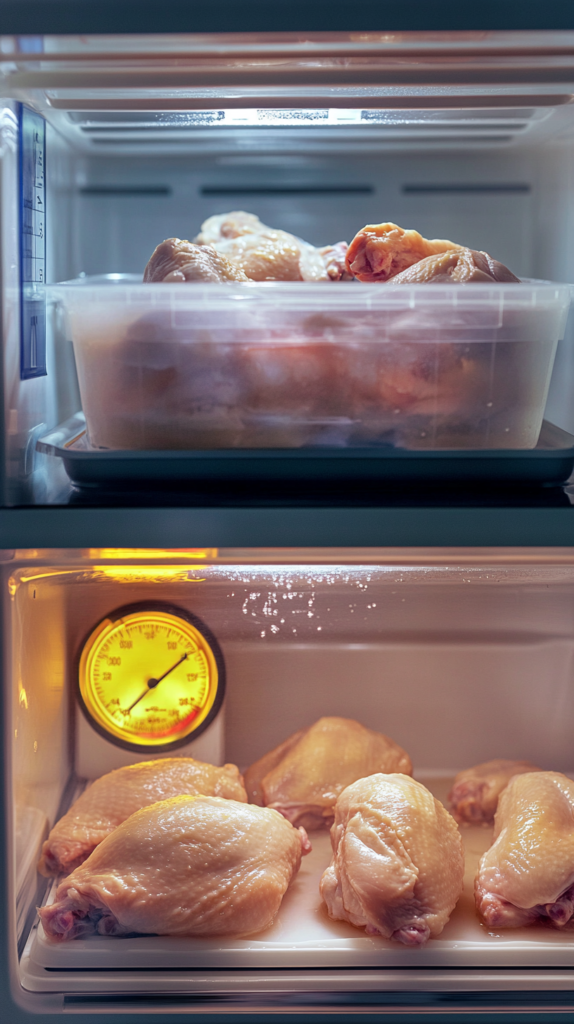
Can You Cook Frozen Chicken in a Crock-Pot?
Why Some Recipes Recommend It
Some recipes suggest cooking frozen chicken in a Crock-Pot because the slow cooker gradually increases the temperature. However, this approach comes with significant risks.
Potential Risks and Tips
Cooking frozen chicken in a Crock-Pot may result in:
- Extended cooking times, which can cause uneven cooking.
- The chicken remaining in the bacterial “danger zone” for too long.
If you choose to cook frozen chicken, follow these tips:
- Use smaller pieces of chicken to ensure quicker cooking.
- Avoid using this method for whole or bone-in chicken, as it takes longer to cook through.
- Monitor the internal temperature of the chicken with a meat thermometer. Ensure it reaches at least 165°F.
FAQs: Defrosting Chicken for a Crock-Pot
How to defrost chicken before a slow cooker?
To defrost chicken before using a slow cooker, choose a safe and effective method to ensure the chicken is fully thawed. The refrigerator method is the safest, involving placing chicken in a leak-proof bag or container and allowing it to thaw in the refrigerator for 12–48 hours, depending on the size. For quicker options, use the cold water method (submerging chicken in cold water and changing the water every 30 minutes) or the microwave method (using the defrost setting and rotating the chicken frequently). Always ensure the chicken is soft and pliable throughout with no ice crystals before cooking.
Can I put frozen chicken in the Crock-Pot?
Yes, you can technically put frozen chicken in a Crock-Pot, but it’s not recommended due to food safety concerns. Frozen chicken may stay in the bacterial “danger zone” (40°F–140°F) for too long as it slowly thaws and cooks, increasing the risk of foodborne illnesses. Additionally, frozen chicken may cook unevenly in a slow cooker, resulting in inconsistent textures. If you decide to cook frozen chicken, use smaller pieces and ensure the internal temperature reaches 165°F with a meat thermometer.
How can I defrost chicken quickly?
The fastest ways to defrost chicken are the cold water method and the microwave method:
- Cold Water Method: Place the chicken in a sealed plastic bag and submerge it in cold water. Change the water every 30 minutes to maintain a safe temperature. This method typically takes 2–3 hours for smaller pieces and up to 6 hours for larger cuts.
- Microwave Method: Use your microwave’s defrost setting, selecting the appropriate weight. Rotate the chicken frequently to ensure even thawing. Be prepared to cook the chicken immediately after defrosting, as parts may begin to cook during the process.
What not to do when defrosting chicken?
When defrosting chicken, avoid these unsafe practices to prevent foodborne illness or compromised cooking quality:
- Do not defrost chicken at room temperature: The outer layers may reach unsafe temperatures while the interior remains frozen, encouraging bacterial growth.
- Do not use hot water: Similar to room temperature defrosting, hot water can cause uneven thawing and promote bacteria.
- Avoid refreezing chicken after it has thawed: Thawed chicken should be cooked immediately or refrigerated for no more than one to two days.
- Do not skip the defrosting step altogether for Crock-Pot cooking: Cooking frozen chicken directly in a Crock-Pot can result in uneven cooking and unsafe food.
Always prioritize safety and follow proven methods for defrosting chicken before cooking.
Conclusion: How Do You Defrost Chicken Before a Crock-Pot?
Summarizing Best Practices
Defrosting chicken safely before using a Crock-Pot is an essential step in preparing healthy, delicious meals. Whether you’re planning a comforting stew or a flavorful soup, ensuring your chicken is fully thawed will significantly impact the outcome of your dish. Always follow these key practices to guarantee success:
- Choose a safe defrosting method: Opt for refrigeration, cold water, or the microwave to thaw chicken safely before using a Crock-Pot. Each method offers unique advantages depending on your timing and needs.
- Handle raw chicken with care: Prevent contamination by using clean tools and surfaces and washing your hands thoroughly after handling chicken.
- Plan ahead for proper defrosting: Ensuring you have enough time to defrost chicken before a Crock-Pot meal will help you avoid rushed or unsafe practices.
By sticking to these guidelines on how do you defrost chicken before a Crock-Pot, you can confidently prepare meals that are safe, flavorful, and perfectly cooked every time.


